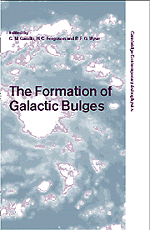Book contents
- Frontmatter
- Contents
- Preface
- Dedication: In Memory of Olin Eggen
- Part 1 Introduction
- Part 2 The Epoch of Bulge Formation
- Part 3 The Timescales of Bulge Formation
- Part 4 Physical Processes in Bulge Formation
- The Role of Bars for Secular Bulge Formation
- Bars and Boxy/Peanut-Shaped Bulges: An Observational Point of View
- Boxy- and Peanut-Shaped Bulges
- A New Class of Bulges
- The Role of Secondary Bars in Bulge Formation
- Radial Transport of Molecular Gas to the Nuclei of Spiral Galaxies
- Dynamical Evolution of Bulge Shapes
- Two-Component Stellar Systems: Phase-Space Constraints
- Central NGC 2146 – A Firehose-Type Bending Instability?
- Bulge Formation: The Role of the Multi-Phase ISM
- Global Evolution of a Self-Gravitating Multi-Phase ISM in the Central Kpc Region of Galaxies
- Part 5 Bulge Phenomenology
- Part 6 Conference Summary
- Index
Bars and Boxy/Peanut-Shaped Bulges: An Observational Point of View
from Part 4 - Physical Processes in Bulge Formation
Published online by Cambridge University Press: 10 November 2010
- Frontmatter
- Contents
- Preface
- Dedication: In Memory of Olin Eggen
- Part 1 Introduction
- Part 2 The Epoch of Bulge Formation
- Part 3 The Timescales of Bulge Formation
- Part 4 Physical Processes in Bulge Formation
- The Role of Bars for Secular Bulge Formation
- Bars and Boxy/Peanut-Shaped Bulges: An Observational Point of View
- Boxy- and Peanut-Shaped Bulges
- A New Class of Bulges
- The Role of Secondary Bars in Bulge Formation
- Radial Transport of Molecular Gas to the Nuclei of Spiral Galaxies
- Dynamical Evolution of Bulge Shapes
- Two-Component Stellar Systems: Phase-Space Constraints
- Central NGC 2146 – A Firehose-Type Bending Instability?
- Bulge Formation: The Role of the Multi-Phase ISM
- Global Evolution of a Self-Gravitating Multi-Phase ISM in the Central Kpc Region of Galaxies
- Part 5 Bulge Phenomenology
- Part 6 Conference Summary
- Index
Summary
Prompted by work on the buckling instability in barred spiral galaxies, much effort has been devoted lately to the study of boxy/peanut-shaped bulges. Here, we present new bar diagnostics for edge-on spiral galaxies based on periodic orbits calculations and hydrodynamical simulations. Both approaches provide reliable ways to identify bars and their orientations in edge-on systems. We also present the results of an observational search for bars in a large sample of edge-on spirals with and without boxy/peanut-shaped bulges. We show that most such bulges are due to the presence of a thick bar viewed edge-on while only a few may be due to accretion. This strongly supports the bar-buckling mechanism for the formation of boxy/peanut-shaped bulges.
Introduction
Boxy/peanut-shaped bulges (hereafter referred to simply as boxy bulges) have, as their name indicates, excess light above the plane. They are thus easily identified in edge-on systems and display many interesting properties: their luminosity excess, an extreme three-dimensional structure, probable cylindrical rotation, etc. However, the main importance of boxy bulges resides in their incidence: at least 20-30% of all spiral galaxies possess a boxy or peanut-shaped bulge. They are thus essential to our understanding of bulge formation and evolution.
Early theories on the formation of boxy bulges were centered around accretion scenarios, where one or many satellites galaxies are accreted onto a preexisting bulge, and which lead to axisymmetric structures (e.g. Binney & Petrou 1985).
- Type
- Chapter
- Information
- The Formation of Galactic Bulges , pp. 115 - 118Publisher: Cambridge University PressPrint publication year: 2000
- 1
- Cited by



